
claude-task-master
An AI-powered task-management system you can drop into Cursor, Lovable, Windsurf, Roo, and others.
Stars: 22255
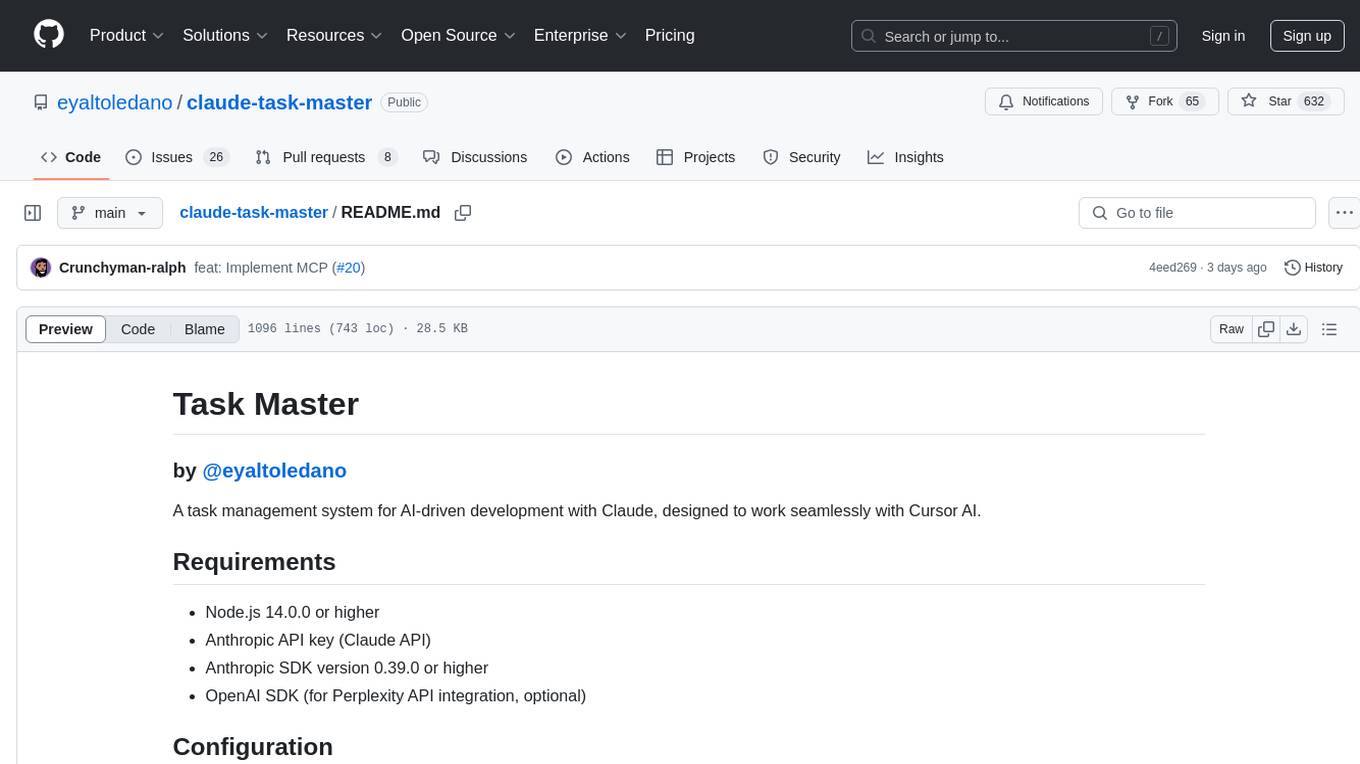
Claude Task Master is a task management system designed for AI-driven development with Claude, seamlessly integrating with Cursor AI. It allows users to configure tasks through environment variables, parse PRD documents, generate structured tasks with dependencies and priorities, and manage task status. The tool supports task expansion, complexity analysis, and smart task recommendations. Users can interact with the system through CLI commands for task discovery, implementation, verification, and completion. It offers features like task breakdown, dependency management, and AI-driven task generation, providing a structured workflow for efficient development.
README:
Taskmaster: A task management system for AI-driven development, designed to work seamlessly with any AI chat.
|
Docs
By @eyaltoledano & @RalphEcom
A task management system for AI-driven development with Claude, designed to work seamlessly with Cursor AI.
For detailed guides, API references, and comprehensive examples, visit our documentation site.
The following documentation is also available in the docs directory:
- Configuration Guide - Set up environment variables and customize Task Master
- Tutorial - Step-by-step guide to getting started with Task Master
- Command Reference - Complete list of all available commands
- Task Structure - Understanding the task format and features
- Example Interactions - Common Cursor AI interaction examples
- Migration Guide - Guide to migrating to the new project structure
Note: After clicking the link, you'll still need to add your API keys to the configuration. The link installs the MCP server with placeholder keys that you'll need to replace with your actual API keys.
Taskmaster utilizes AI across several commands, and those require a separate API key. You can use a variety of models from different AI providers provided you add your API keys. For example, if you want to use Claude 3.7, you'll need an Anthropic API key.
You can define 3 types of models to be used: the main model, the research model, and the fallback model (in case either the main or research fail). Whatever model you use, its provider API key must be present in either mcp.json or .env.
At least one (1) of the following is required:
- Anthropic API key (Claude API)
- OpenAI API key
- Google Gemini API key
- Perplexity API key (for research model)
- xAI API Key (for research or main model)
- OpenRouter API Key (for research or main model)
- Claude Code (no API key required - requires Claude Code CLI)
Using the research model is optional but highly recommended. You will need at least ONE API key (unless using Claude Code). Adding all API keys enables you to seamlessly switch between model providers at will.
MCP (Model Control Protocol) lets you run Task Master directly from your editor.
| Editor | Scope | Linux/macOS Path | Windows Path | Key |
|---|---|---|---|---|
| Cursor | Global | ~/.cursor/mcp.json |
%USERPROFILE%\.cursor\mcp.json |
mcpServers |
| Project | <project_folder>/.cursor/mcp.json |
<project_folder>\.cursor\mcp.json |
mcpServers |
|
| Windsurf | Global | ~/.codeium/windsurf/mcp_config.json |
%USERPROFILE%\.codeium\windsurf\mcp_config.json |
mcpServers |
| VS Code | Project | <project_folder>/.vscode/mcp.json |
<project_folder>\.vscode\mcp.json |
servers |
{
"mcpServers": {
"task-master-ai": {
"command": "npx",
"args": ["-y", "task-master-ai"],
"env": {
"ANTHROPIC_API_KEY": "YOUR_ANTHROPIC_API_KEY_HERE",
"PERPLEXITY_API_KEY": "YOUR_PERPLEXITY_API_KEY_HERE",
"OPENAI_API_KEY": "YOUR_OPENAI_KEY_HERE",
"GOOGLE_API_KEY": "YOUR_GOOGLE_KEY_HERE",
"MISTRAL_API_KEY": "YOUR_MISTRAL_KEY_HERE",
"GROQ_API_KEY": "YOUR_GROQ_KEY_HERE",
"OPENROUTER_API_KEY": "YOUR_OPENROUTER_KEY_HERE",
"XAI_API_KEY": "YOUR_XAI_KEY_HERE",
"AZURE_OPENAI_API_KEY": "YOUR_AZURE_KEY_HERE",
"OLLAMA_API_KEY": "YOUR_OLLAMA_API_KEY_HERE"
}
}
}
}🔑 Replace
YOUR_…_KEY_HEREwith your real API keys. You can remove keys you don't use.
Note: If you see
0 tools enabledin the MCP settings, restart your editor and check that your API keys are correctly configured.
{
"servers": {
"task-master-ai": {
"command": "npx",
"args": ["-y", "task-master-ai"],
"env": {
"ANTHROPIC_API_KEY": "YOUR_ANTHROPIC_API_KEY_HERE",
"PERPLEXITY_API_KEY": "YOUR_PERPLEXITY_API_KEY_HERE",
"OPENAI_API_KEY": "YOUR_OPENAI_KEY_HERE",
"GOOGLE_API_KEY": "YOUR_GOOGLE_KEY_HERE",
"MISTRAL_API_KEY": "YOUR_MISTRAL_KEY_HERE",
"GROQ_API_KEY": "YOUR_GROQ_KEY_HERE",
"OPENROUTER_API_KEY": "YOUR_OPENROUTER_KEY_HERE",
"XAI_API_KEY": "YOUR_XAI_KEY_HERE",
"AZURE_OPENAI_API_KEY": "YOUR_AZURE_KEY_HERE",
"OLLAMA_API_KEY": "YOUR_OLLAMA_API_KEY_HERE"
},
"type": "stdio"
}
}
}🔑 Replace
YOUR_…_KEY_HEREwith your real API keys. You can remove keys you don't use.
Open Cursor Settings (Ctrl+Shift+J) ➡ Click on MCP tab on the left ➡ Enable task-master-ai with the toggle
In your editor's AI chat pane, say:
Change the main, research and fallback models to <model_name>, <model_name> and <model_name> respectively.For example, to use Claude Code (no API key required):
Change the main model to claude-code/sonnetTable of available models | Claude Code setup
In your editor's AI chat pane, say:
Initialize taskmaster-ai in my projectFor new projects: Create your PRD at .taskmaster/docs/prd.txt
For existing projects: You can use scripts/prd.txt or migrate with task-master migrate
An example PRD template is available after initialization in .taskmaster/templates/example_prd.txt.
[!NOTE] While a PRD is recommended for complex projects, you can always create individual tasks by asking "Can you help me implement [description of what you want to do]?" in chat.
Always start with a detailed PRD.
The more detailed your PRD, the better the generated tasks will be.
Use your AI assistant to:
- Parse requirements:
Can you parse my PRD at scripts/prd.txt? - Plan next step:
What's the next task I should work on? - Implement a task:
Can you help me implement task 3? - View multiple tasks:
Can you show me tasks 1, 3, and 5? - Expand a task:
Can you help me expand task 4? -
Research fresh information:
Research the latest best practices for implementing JWT authentication with Node.js -
Research with context:
Research React Query v5 migration strategies for our current API implementation in src/api.js
More examples on how to use Task Master in chat
# Install globally
npm install -g task-master-ai
# OR install locally within your project
npm install task-master-ai# If installed globally
task-master init
# If installed locally
npx task-master init
# Initialize project with specific rules
task-master init --rules cursor,windsurf,vscodeThis will prompt you for project details and set up a new project with the necessary files and structure.
# Initialize a new project
task-master init
# Parse a PRD and generate tasks
task-master parse-prd your-prd.txt
# List all tasks
task-master list
# Show the next task to work on
task-master next
# Show specific task(s) - supports comma-separated IDs
task-master show 1,3,5
# Research fresh information with project context
task-master research "What are the latest best practices for JWT authentication?"
# Move tasks between tags (cross-tag movement)
task-master move --from=5 --from-tag=backlog --to-tag=in-progress
task-master move --from=5,6,7 --from-tag=backlog --to-tag=done --with-dependencies
task-master move --from=5 --from-tag=backlog --to-tag=in-progress --ignore-dependencies
# Generate task files
task-master generate
# Add rules after initialization
task-master rules add windsurf,roo,vscodeTask Master now supports Claude models through the Claude Code CLI, which requires no API key:
-
Models:
claude-code/opusandclaude-code/sonnet - Requirements: Claude Code CLI installed
- Benefits: No API key needed, uses your local Claude instance
Learn more about Claude Code setup
Try running it with Node directly:
node node_modules/claude-task-master/scripts/init.jsOr clone the repository and run:
git clone https://github.com/eyaltoledano/claude-task-master.git
cd claude-task-master
node scripts/init.jsTask Master is licensed under the MIT License with Commons Clause. This means you can:
✅ Allowed:
- Use Task Master for any purpose (personal, commercial, academic)
- Modify the code
- Distribute copies
- Create and sell products built using Task Master
❌ Not Allowed:
- Sell Task Master itself
- Offer Task Master as a hosted service
- Create competing products based on Task Master
See the LICENSE file for the complete license text and licensing details for more information.
For Tasks:
Click tags to check more tools for each tasksFor Jobs:
Alternative AI tools for claude-task-master
Similar Open Source Tools

claude-task-master
Claude Task Master is a task management system designed for AI-driven development with Claude, seamlessly integrating with Cursor AI. It allows users to configure tasks through environment variables, parse PRD documents, generate structured tasks with dependencies and priorities, and manage task status. The tool supports task expansion, complexity analysis, and smart task recommendations. Users can interact with the system through CLI commands for task discovery, implementation, verification, and completion. It offers features like task breakdown, dependency management, and AI-driven task generation, providing a structured workflow for efficient development.
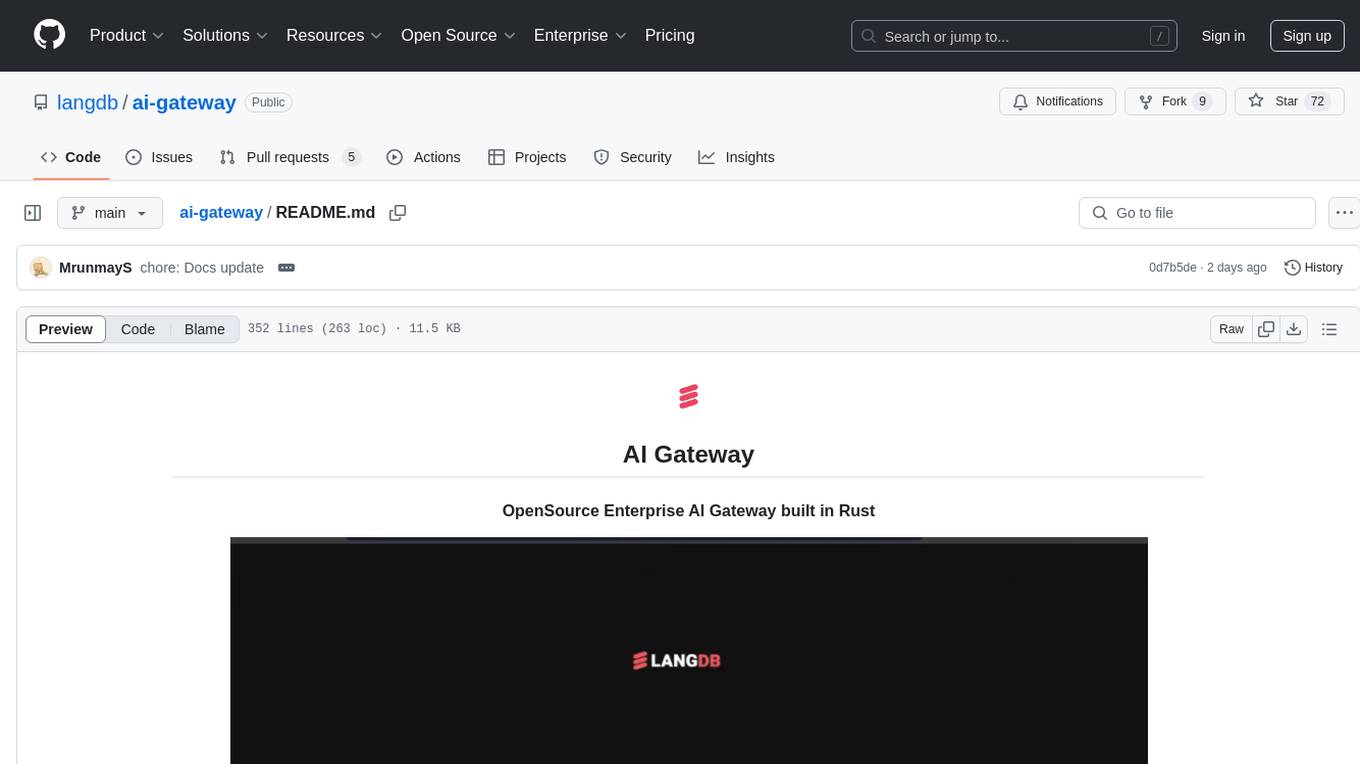
ai-gateway
LangDB AI Gateway is an open-source enterprise AI gateway built in Rust. It provides a unified interface to all LLMs using the OpenAI API format, focusing on high performance, enterprise readiness, and data control. The gateway offers features like comprehensive usage analytics, cost tracking, rate limiting, data ownership, and detailed logging. It supports various LLM providers and provides OpenAI-compatible endpoints for chat completions, model listing, embeddings generation, and image generation. Users can configure advanced settings, such as rate limiting, cost control, dynamic model routing, and observability with OpenTelemetry tracing. The gateway can be run with Docker Compose and integrated with MCP tools for server communication.
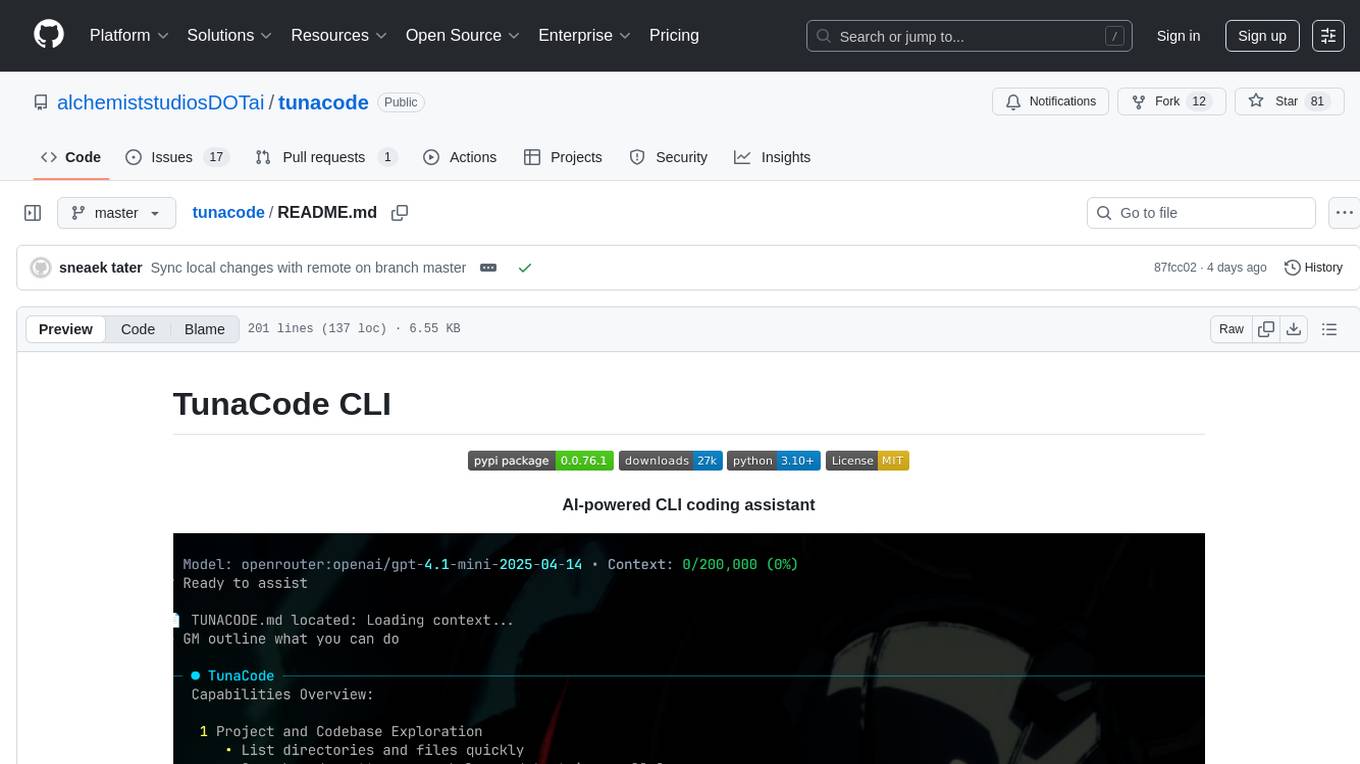
tunacode
TunaCode CLI is an AI-powered coding assistant that provides a command-line interface for developers to enhance their coding experience. It offers features like model selection, parallel execution for faster file operations, and various commands for code management. The tool aims to improve coding efficiency and provide a seamless coding environment for developers.
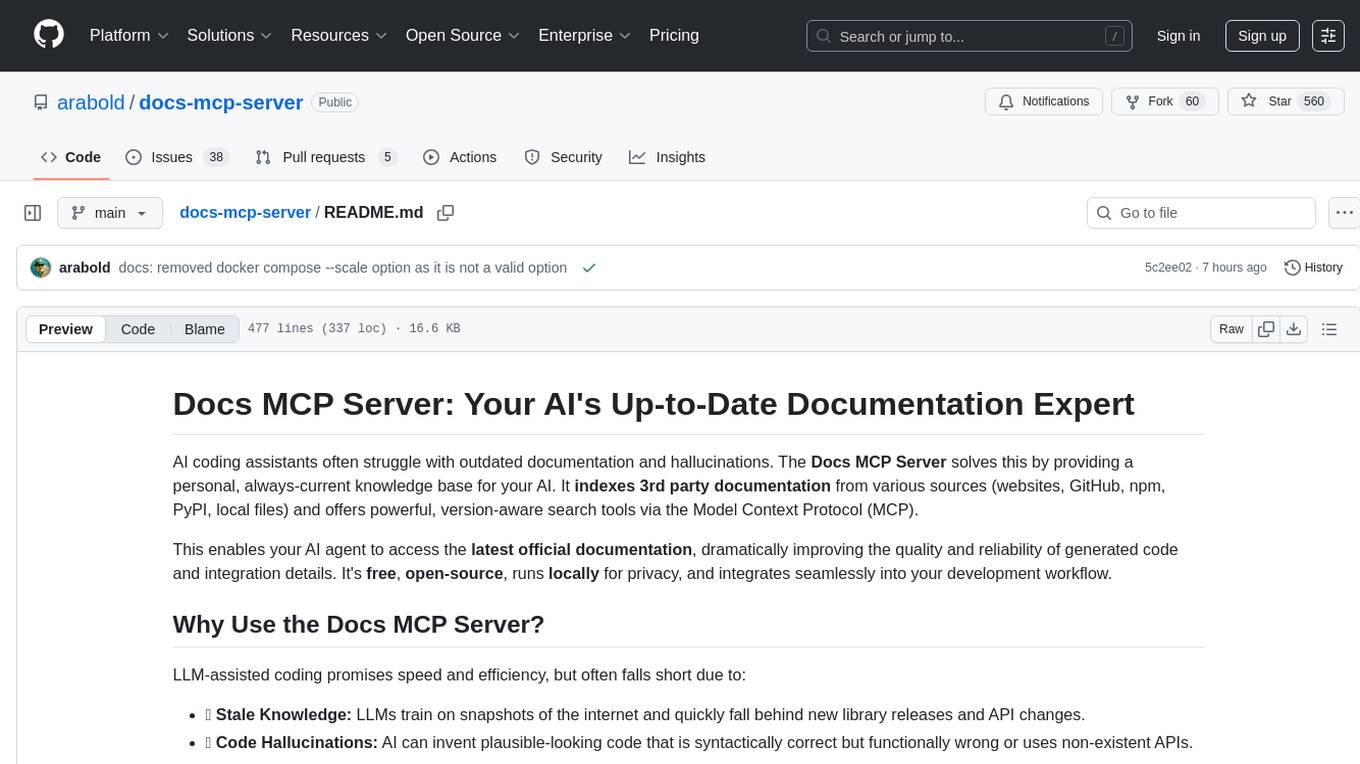
docs-mcp-server
The docs-mcp-server repository contains the server-side code for the documentation management system. It provides functionalities for managing, storing, and retrieving documentation files. Users can upload, update, and delete documents through the server. The server also supports user authentication and authorization to ensure secure access to the documentation system. Additionally, the server includes APIs for integrating with other systems and tools, making it a versatile solution for managing documentation in various projects and organizations.
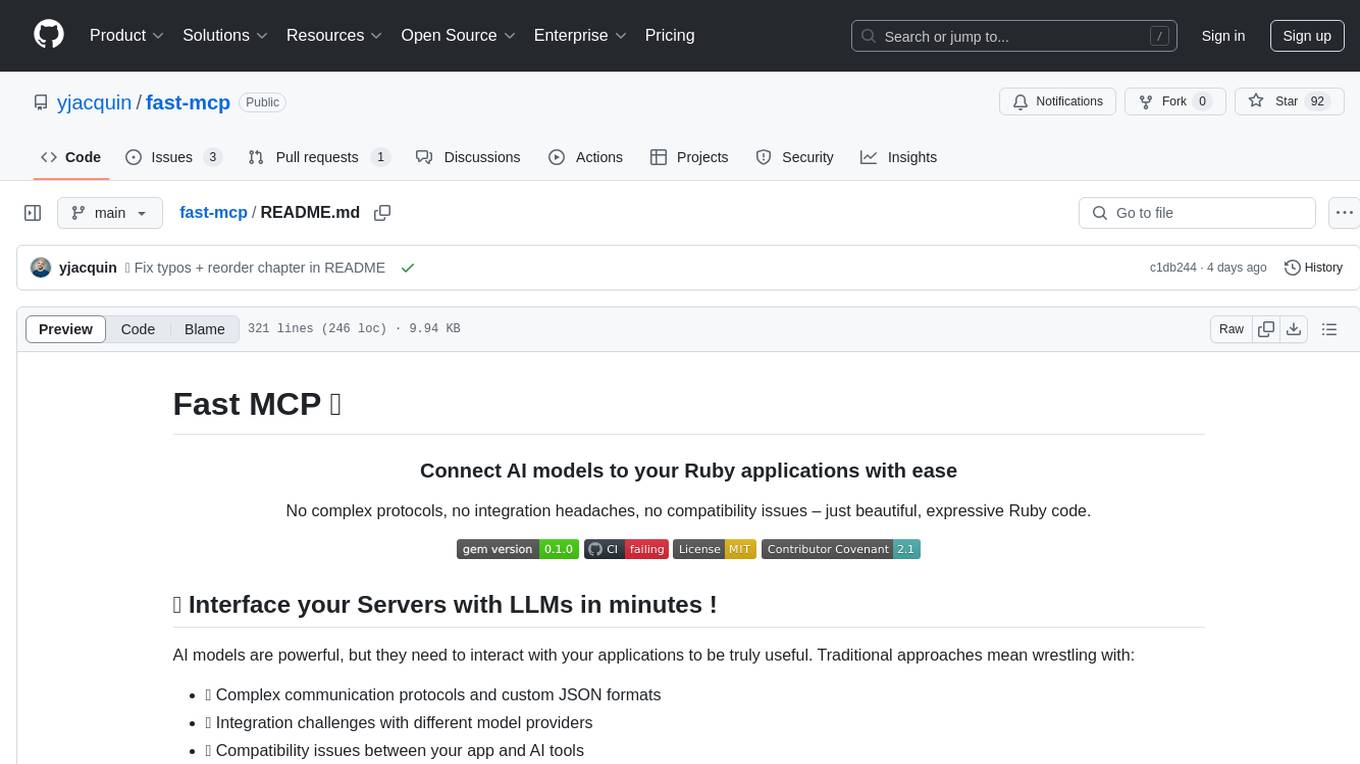
fast-mcp
Fast MCP is a Ruby gem that simplifies the integration of AI models with your Ruby applications. It provides a clean implementation of the Model Context Protocol, eliminating complex communication protocols, integration challenges, and compatibility issues. With Fast MCP, you can easily connect AI models to your servers, share data resources, choose from multiple transports, integrate with frameworks like Rails and Sinatra, and secure your AI-powered endpoints. The gem also offers real-time updates and authentication support, making AI integration a seamless experience for developers.

open-edison
OpenEdison is a secure MCP control panel that connects AI to data/software with additional security controls to reduce data exfiltration risks. It helps address the lethal trifecta problem by providing visibility, monitoring potential threats, and alerting on data interactions. The tool offers features like data leak monitoring, controlled execution, easy configuration, visibility into agent interactions, a simple API, and Docker support. It integrates with LangGraph, LangChain, and plain Python agents for observability and policy enforcement. OpenEdison helps gain observability, control, and policy enforcement for AI interactions with systems of records, existing company software, and data to reduce risks of AI-caused data leakage.
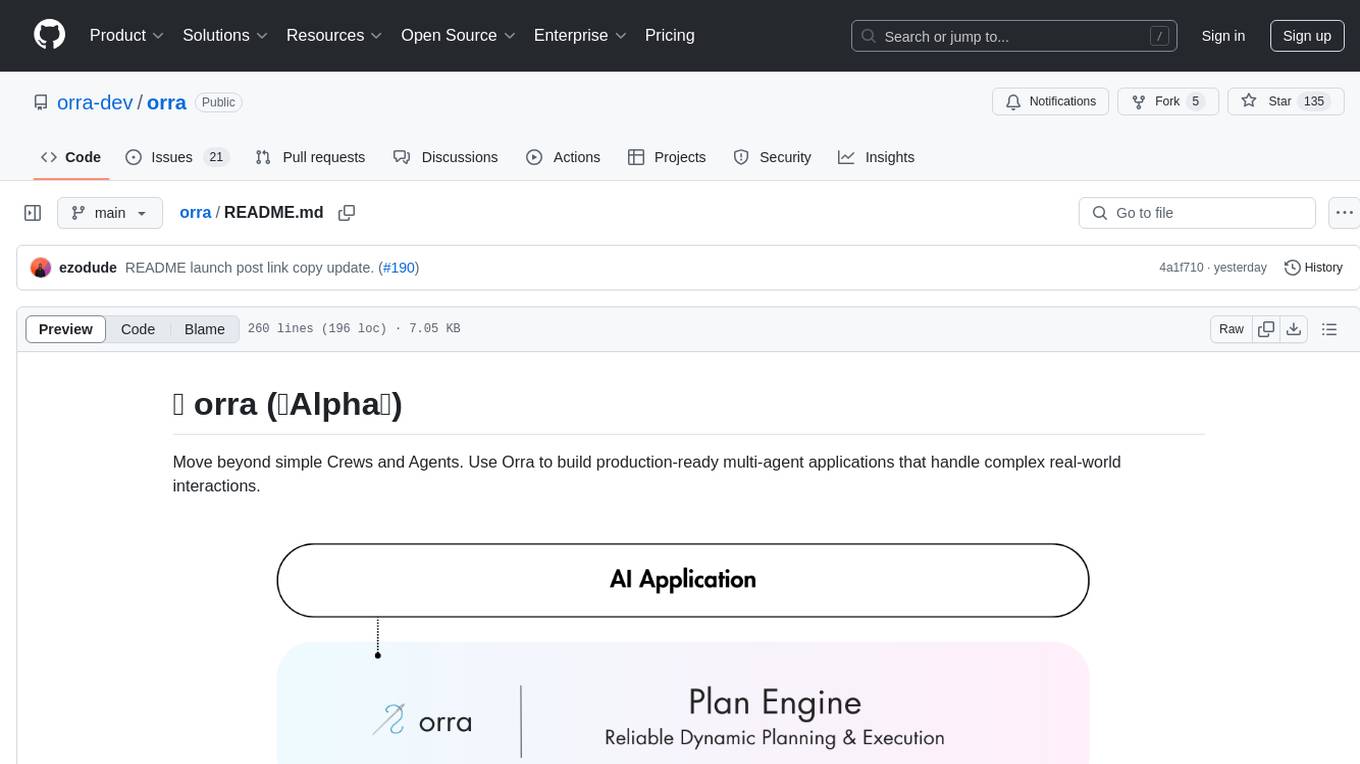
orra
Orra is a tool for building production-ready multi-agent applications that handle complex real-world interactions. It coordinates tasks across existing stack, agents, and tools run as services using intelligent reasoning. With features like smart pre-evaluated execution plans, domain grounding, durable execution, and automatic service health monitoring, Orra enables users to go fast with tools as services and revert state to handle failures. It provides real-time status tracking and webhook result delivery, making it ideal for developers looking to move beyond simple crews and agents.
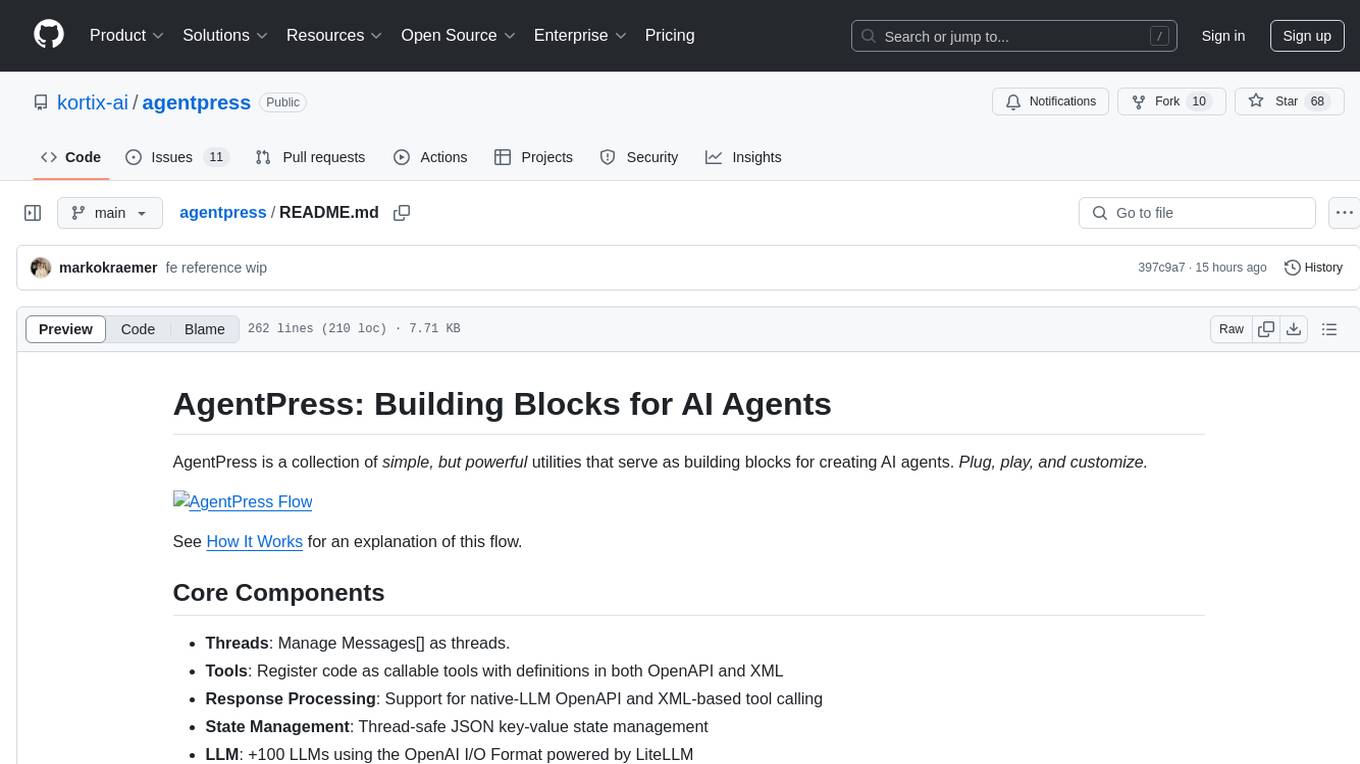
agentpress
AgentPress is a collection of simple but powerful utilities that serve as building blocks for creating AI agents. It includes core components for managing threads, registering tools, processing responses, state management, and utilizing LLMs. The tool provides a modular architecture for handling messages, LLM API calls, response processing, tool execution, and results management. Users can easily set up the environment, create custom tools with OpenAPI or XML schema, and manage conversation threads with real-time interaction. AgentPress aims to be agnostic, simple, and flexible, allowing users to customize and extend functionalities as needed.
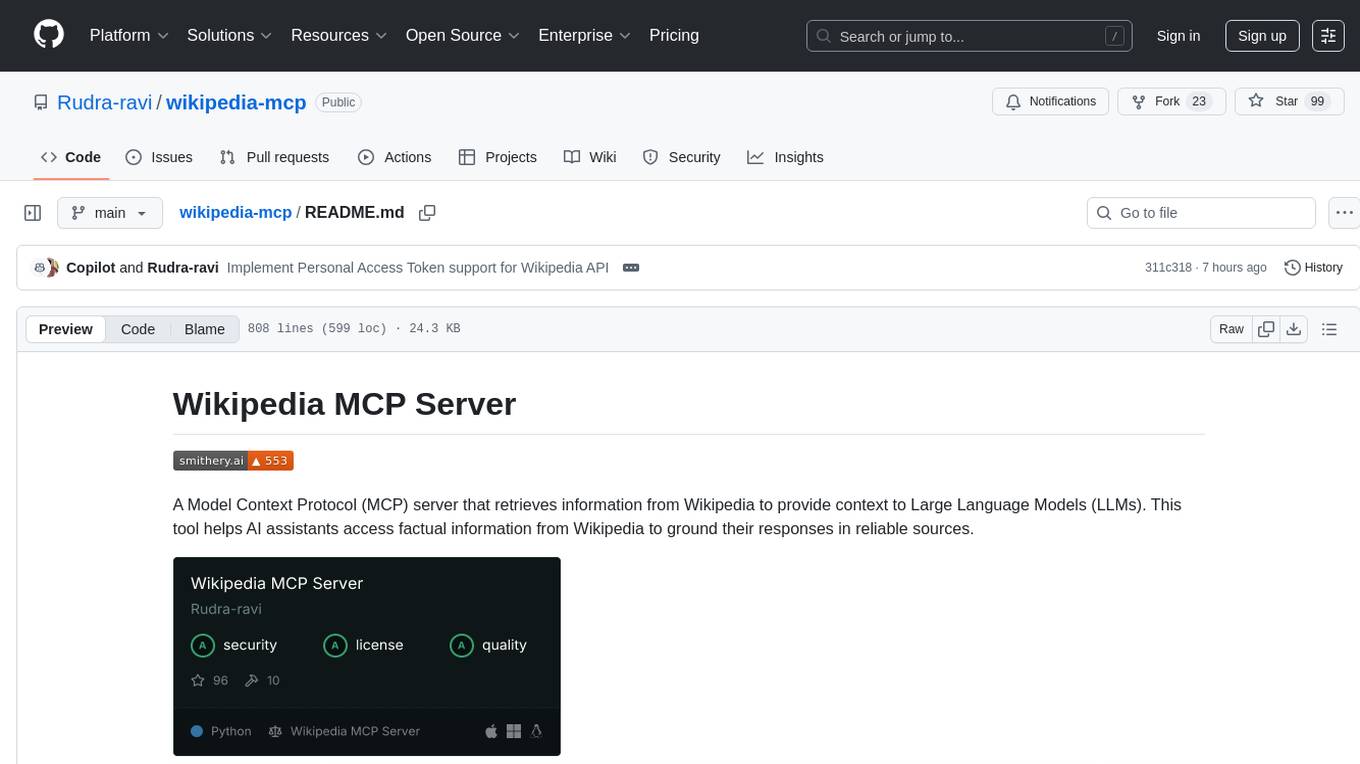
wikipedia-mcp
The Wikipedia MCP Server is a Model Context Protocol (MCP) server that provides real-time access to Wikipedia information for Large Language Models (LLMs). It allows AI assistants to retrieve accurate and up-to-date information from Wikipedia to enhance their responses. The server offers features such as searching Wikipedia, retrieving article content, getting article summaries, extracting specific sections, discovering links within articles, finding related topics, supporting multiple languages and country codes, optional caching for improved performance, and compatibility with Google ADK agents and other AI frameworks. Users can install the server using pipx, Smithery, PyPI, virtual environment, or from source. The server can be run with various options for transport protocol, language, country/locale, caching, access token, and more. It also supports Docker and Kubernetes deployment. The server provides MCP tools for interacting with Wikipedia, such as searching articles, getting article content, summaries, sections, links, coordinates, related topics, and extracting key facts. It also supports country/locale codes and language variants for languages like Chinese, Serbian, Kurdish, and Norwegian. The server includes example prompts for querying Wikipedia and provides MCP resources for interacting with Wikipedia through MCP endpoints. The project structure includes main packages, API implementation, core functionality, utility functions, and a comprehensive test suite for reliability and functionality testing.
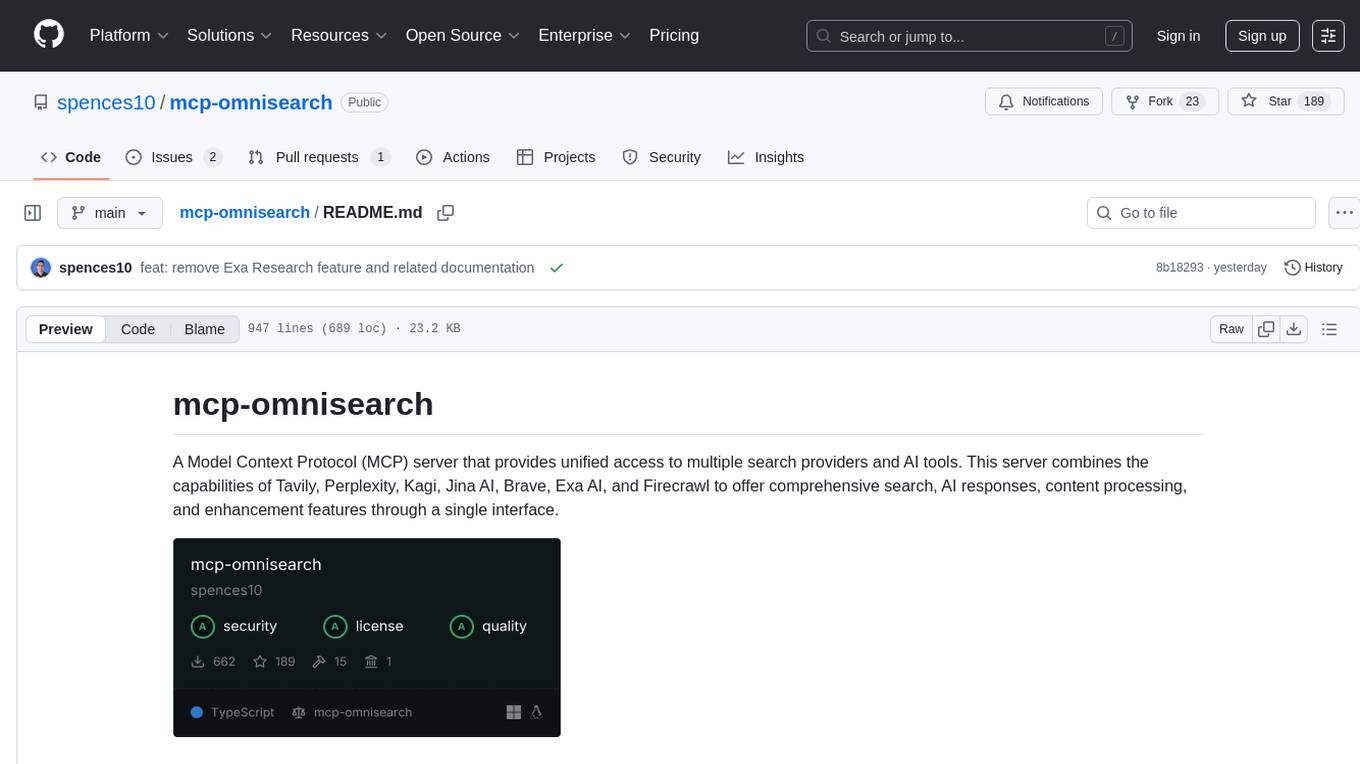
mcp-omnisearch
mcp-omnisearch is a Model Context Protocol (MCP) server that acts as a unified gateway to multiple search providers and AI tools. It integrates Tavily, Perplexity, Kagi, Jina AI, Brave, Exa AI, and Firecrawl to offer a wide range of search, AI response, content processing, and enhancement features through a single interface. The server provides powerful search capabilities, AI response generation, content extraction, summarization, web scraping, structured data extraction, and more. It is designed to work flexibly with the API keys available, enabling users to activate only the providers they have keys for and easily add more as needed.
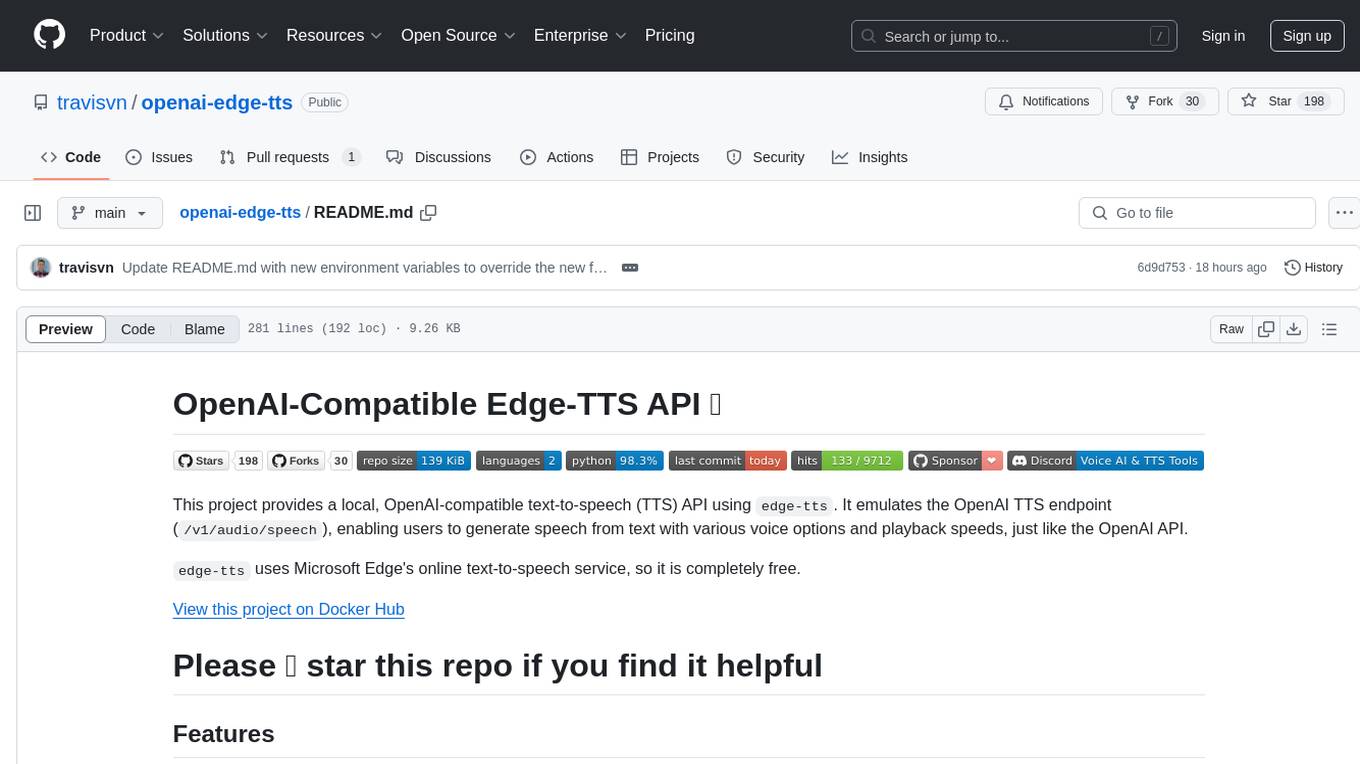
openai-edge-tts
This project provides a local, OpenAI-compatible text-to-speech (TTS) API using `edge-tts`. It emulates the OpenAI TTS endpoint (`/v1/audio/speech`), enabling users to generate speech from text with various voice options and playback speeds, just like the OpenAI API. `edge-tts` uses Microsoft Edge's online text-to-speech service, making it completely free. The project supports multiple audio formats, adjustable playback speed, and voice selection options, providing a flexible and customizable TTS solution for users.
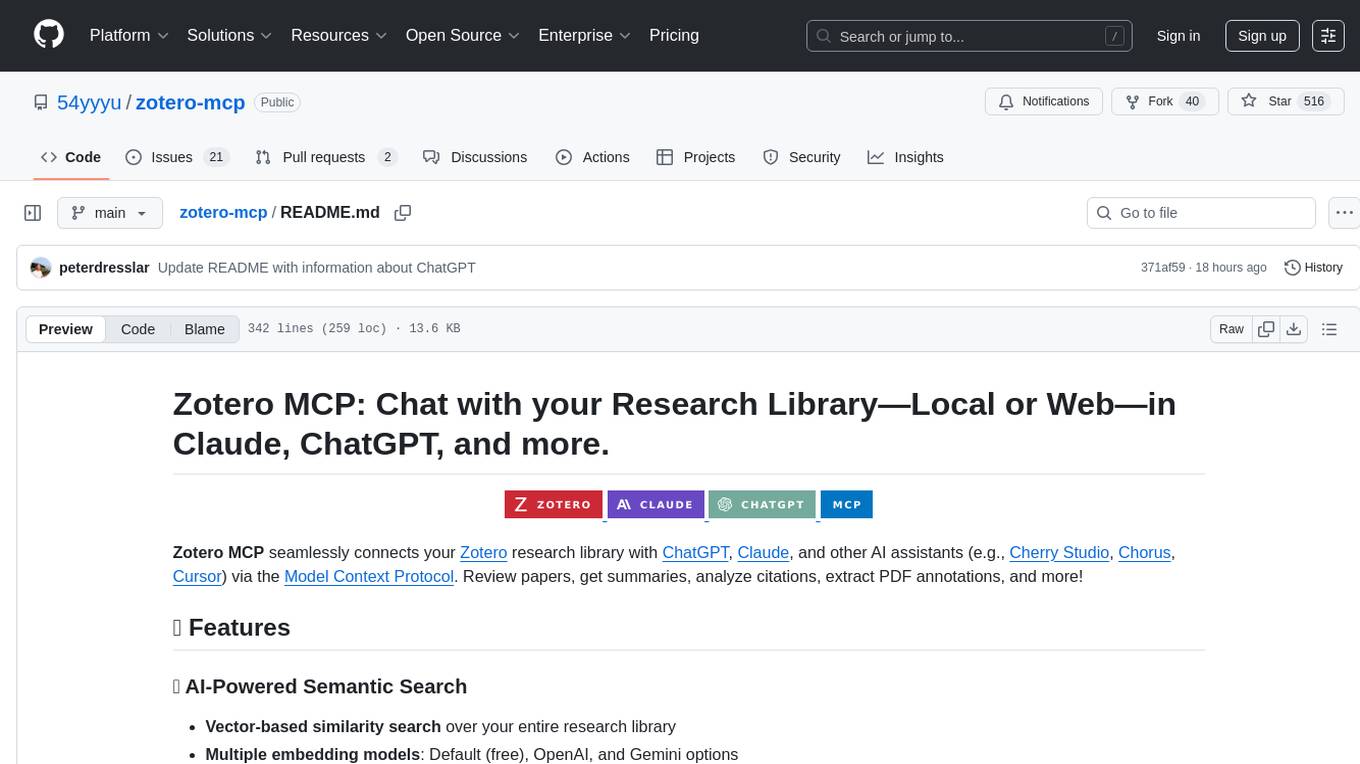
zotero-mcp
Zotero MCP seamlessly connects your Zotero research library with AI assistants like ChatGPT and Claude via the Model Context Protocol. It offers AI-powered semantic search, access to library content, PDF annotation extraction, and easy updates. Users can search their library, analyze citations, and get summaries, making it ideal for research tasks. The tool supports multiple embedding models, intelligent search results, and flexible access methods for both local and remote collaboration. With advanced features like semantic search and PDF annotation extraction, Zotero MCP enhances research efficiency and organization.
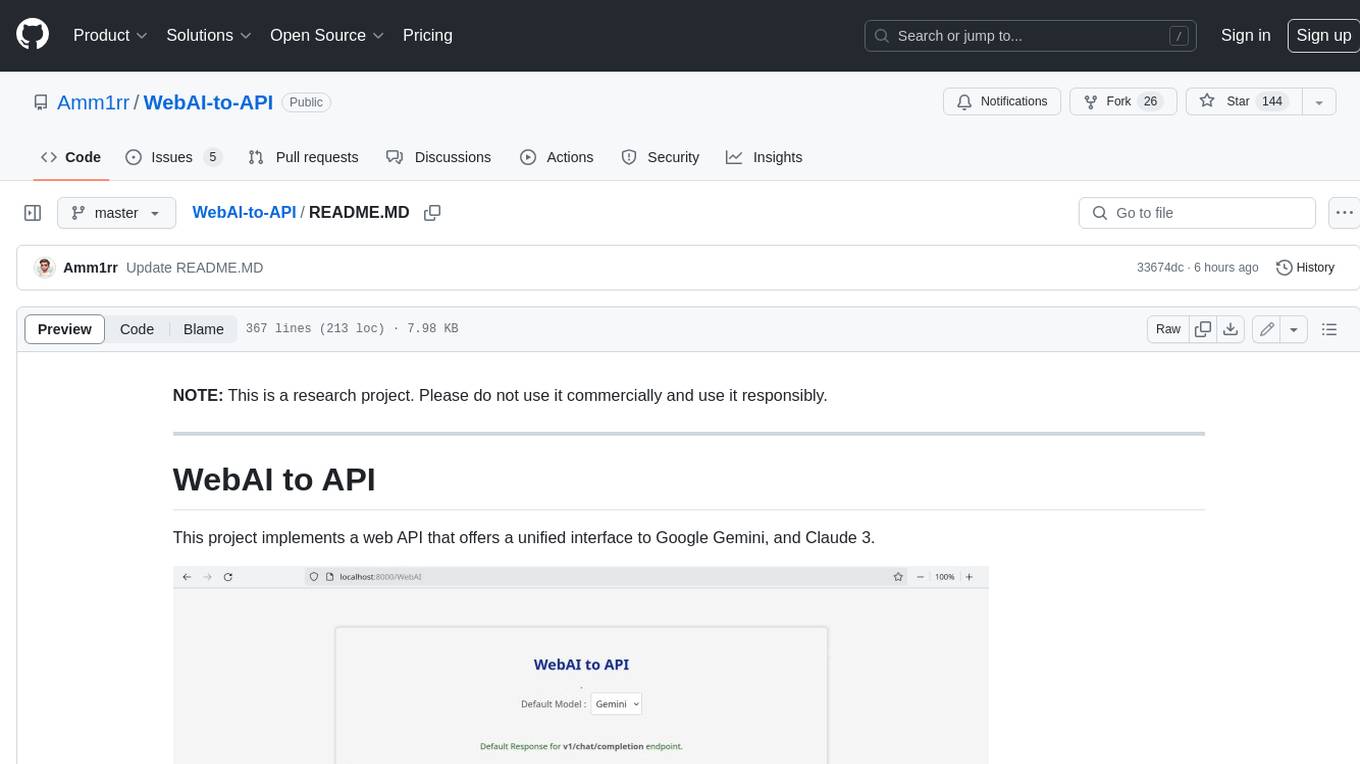
WebAI-to-API
This project implements a web API that offers a unified interface to Google Gemini and Claude 3. It provides a self-hosted, lightweight, and scalable solution for accessing these AI models through a streaming API. The API supports both Claude and Gemini models, allowing users to interact with them in real-time. The project includes a user-friendly web UI for configuration and documentation, making it easy to get started and explore the capabilities of the API.
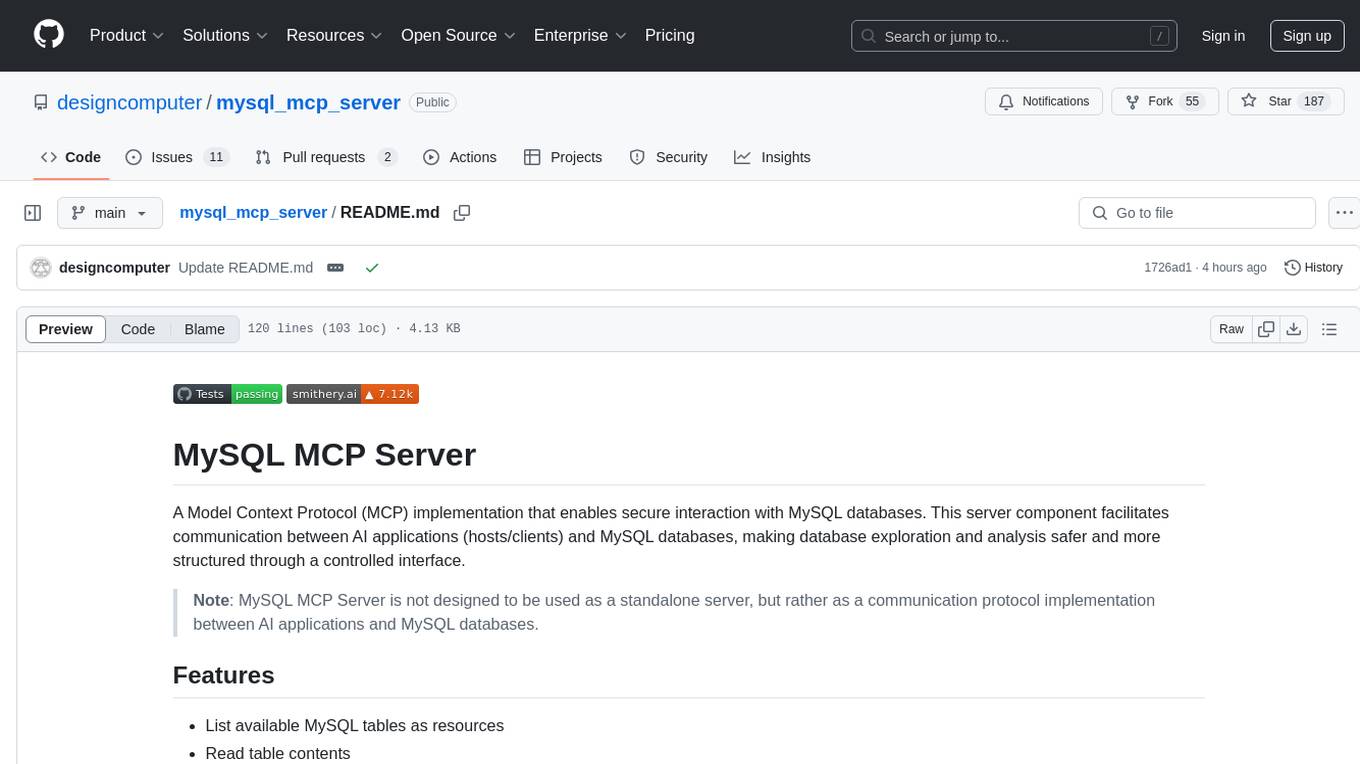
mysql_mcp_server
A Model Context Protocol (MCP) server that enables secure interaction with MySQL databases. This server allows AI assistants to list tables, read data, and execute SQL queries through a controlled interface, making database exploration and analysis safer and more structured. It provides features such as listing available MySQL tables as resources, reading table contents, executing SQL queries with proper error handling, secure database access through environment variables, and comprehensive logging. The tool ensures security best practices by never committing environment variables or credentials, using a database user with minimal required permissions, implementing query whitelisting for production use, and monitoring and logging all database operations.
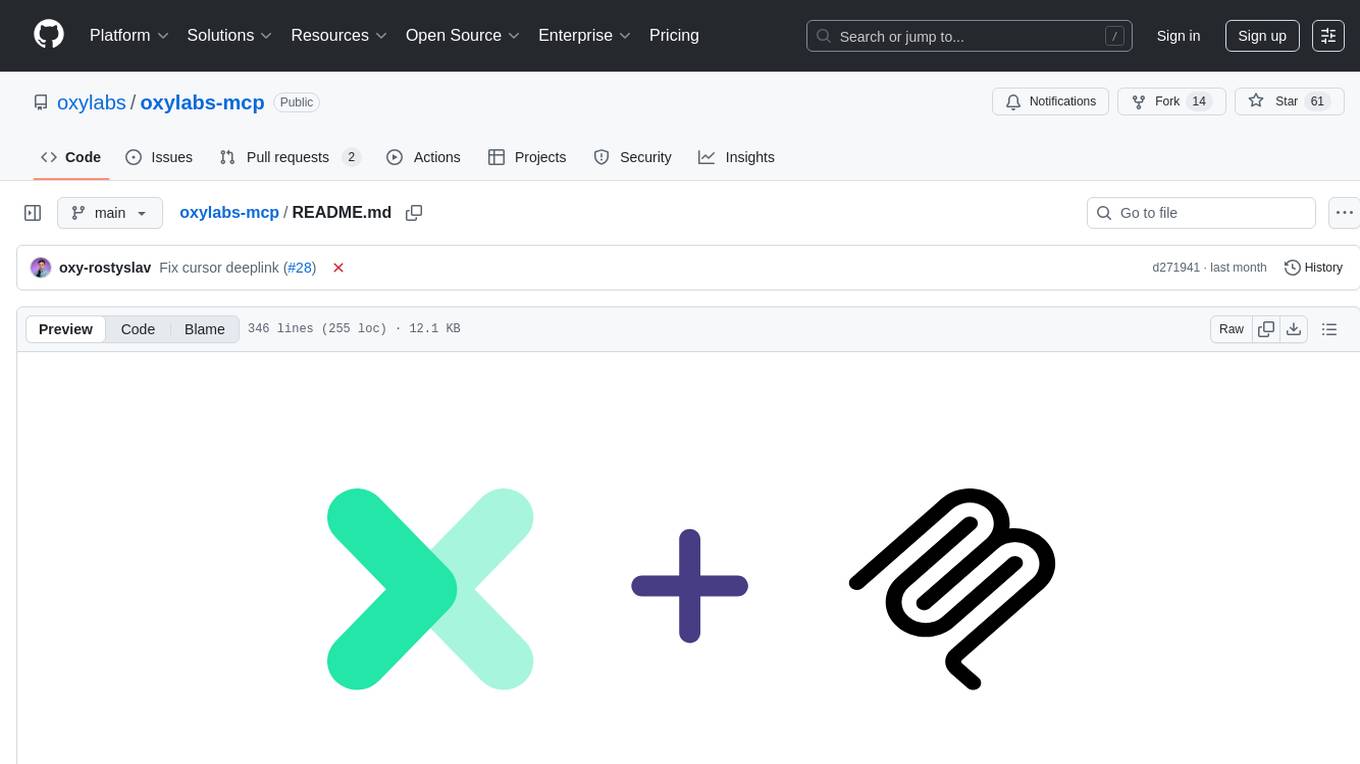
oxylabs-mcp
The Oxylabs MCP Server acts as a bridge between AI models and the web, providing clean, structured data from any site. It enables scraping of URLs, rendering JavaScript-heavy pages, content extraction for AI use, bypassing anti-scraping measures, and accessing geo-restricted web data from 195+ countries. The implementation utilizes the Model Context Protocol (MCP) to facilitate secure interactions between AI assistants and web content. Key features include scraping content from any site, automatic data cleaning and conversion, bypassing blocks and geo-restrictions, flexible setup with cross-platform support, and built-in error handling and request management.
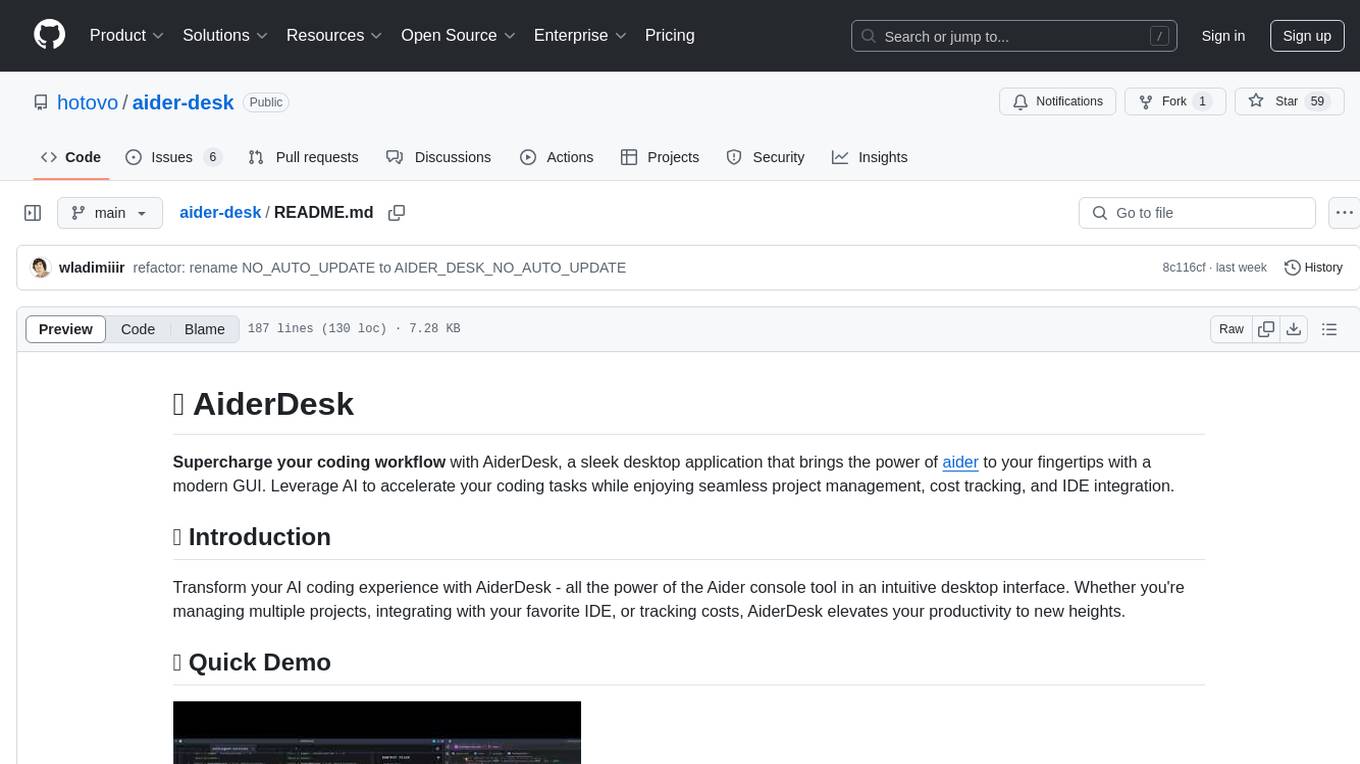
aider-desk
AiderDesk is a desktop application that enhances coding workflow by leveraging AI capabilities. It offers an intuitive GUI, project management, IDE integration, MCP support, settings management, cost tracking, structured messages, visual file management, model switching, code diff viewer, one-click reverts, and easy sharing. Users can install it by downloading the latest release and running the executable. AiderDesk also supports Python version detection and auto update disabling. It includes features like multiple project management, context file management, model switching, chat mode selection, question answering, cost tracking, MCP server integration, and MCP support for external tools and context. Development setup involves cloning the repository, installing dependencies, running in development mode, and building executables for different platforms. Contributions from the community are welcome following specific guidelines.
For similar tasks

claude-task-master
Claude Task Master is a task management system designed for AI-driven development with Claude, seamlessly integrating with Cursor AI. It allows users to configure tasks through environment variables, parse PRD documents, generate structured tasks with dependencies and priorities, and manage task status. The tool supports task expansion, complexity analysis, and smart task recommendations. Users can interact with the system through CLI commands for task discovery, implementation, verification, and completion. It offers features like task breakdown, dependency management, and AI-driven task generation, providing a structured workflow for efficient development.
For similar jobs
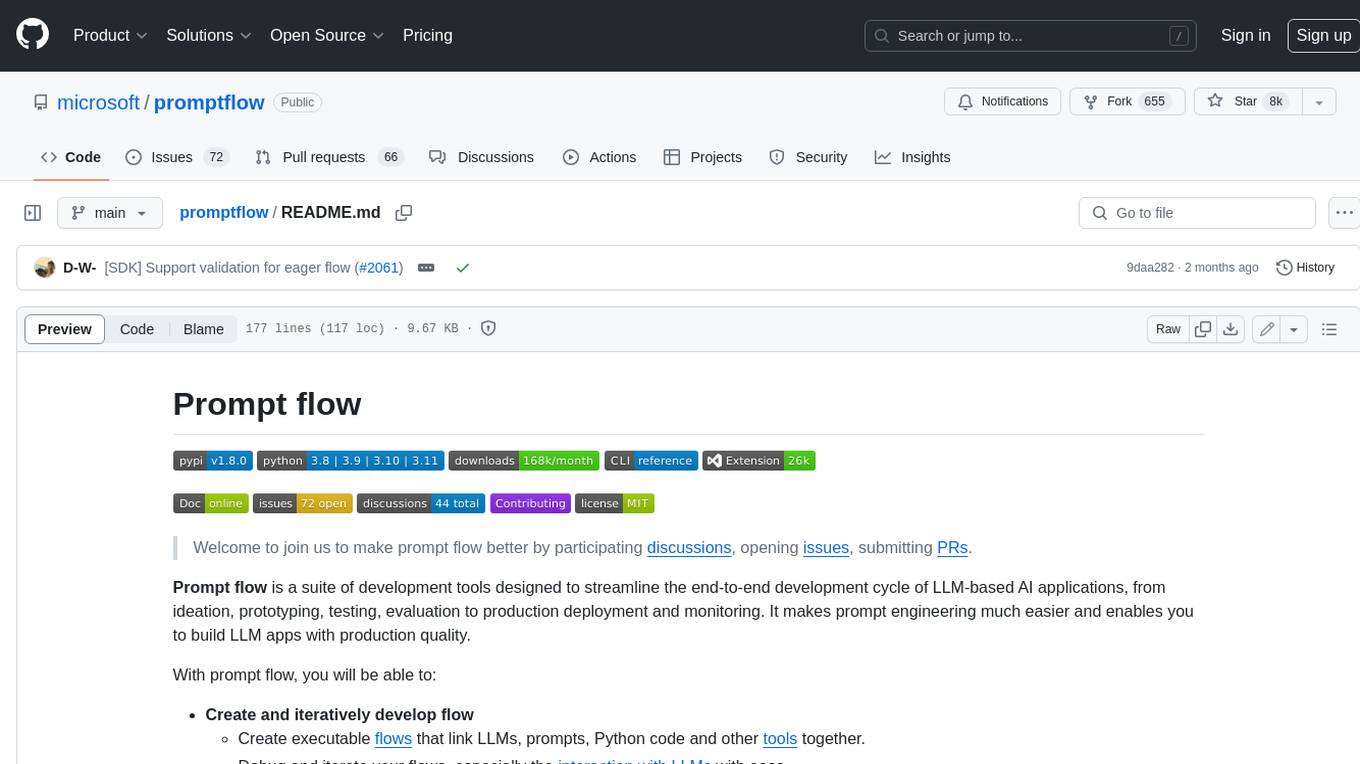
promptflow
**Prompt flow** is a suite of development tools designed to streamline the end-to-end development cycle of LLM-based AI applications, from ideation, prototyping, testing, evaluation to production deployment and monitoring. It makes prompt engineering much easier and enables you to build LLM apps with production quality.
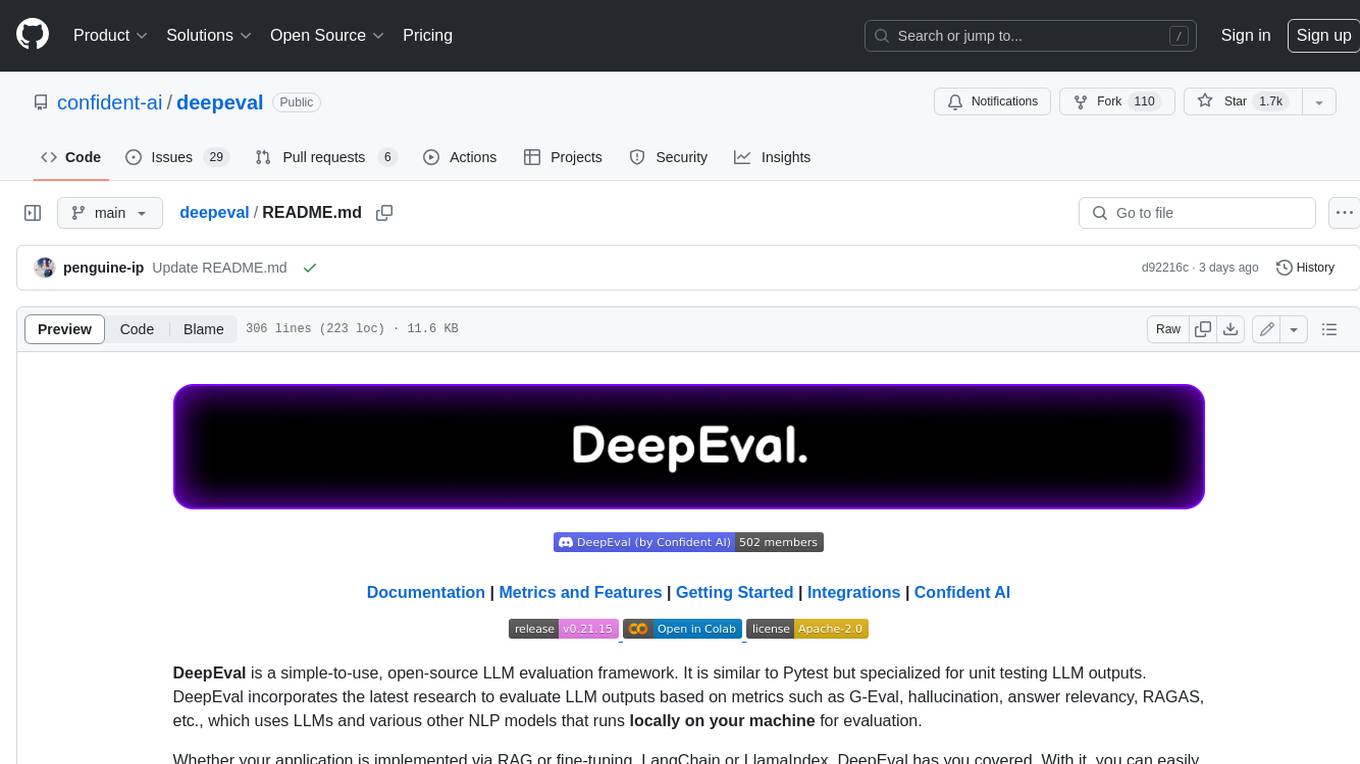
deepeval
DeepEval is a simple-to-use, open-source LLM evaluation framework specialized for unit testing LLM outputs. It incorporates various metrics such as G-Eval, hallucination, answer relevancy, RAGAS, etc., and runs locally on your machine for evaluation. It provides a wide range of ready-to-use evaluation metrics, allows for creating custom metrics, integrates with any CI/CD environment, and enables benchmarking LLMs on popular benchmarks. DeepEval is designed for evaluating RAG and fine-tuning applications, helping users optimize hyperparameters, prevent prompt drifting, and transition from OpenAI to hosting their own Llama2 with confidence.
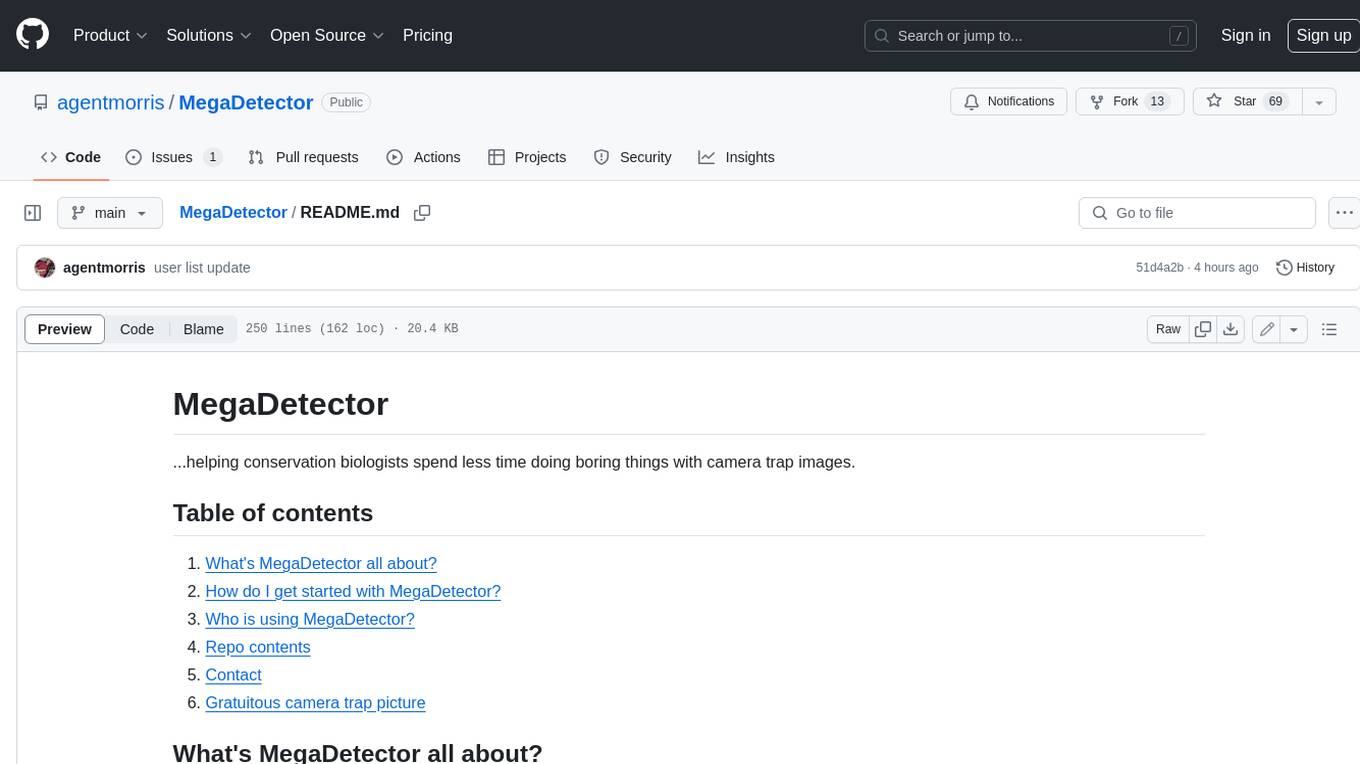
MegaDetector
MegaDetector is an AI model that identifies animals, people, and vehicles in camera trap images (which also makes it useful for eliminating blank images). This model is trained on several million images from a variety of ecosystems. MegaDetector is just one of many tools that aims to make conservation biologists more efficient with AI. If you want to learn about other ways to use AI to accelerate camera trap workflows, check out our of the field, affectionately titled "Everything I know about machine learning and camera traps".
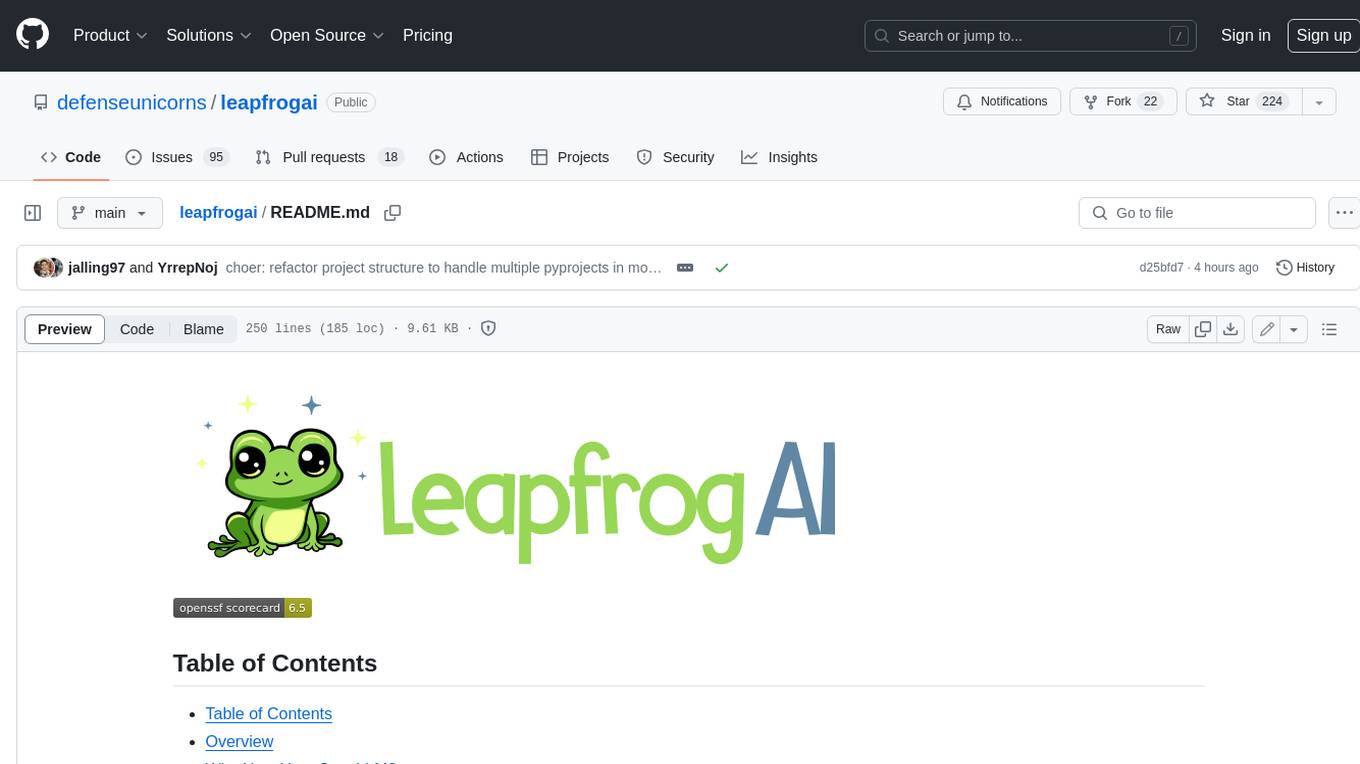
leapfrogai
LeapfrogAI is a self-hosted AI platform designed to be deployed in air-gapped resource-constrained environments. It brings sophisticated AI solutions to these environments by hosting all the necessary components of an AI stack, including vector databases, model backends, API, and UI. LeapfrogAI's API closely matches that of OpenAI, allowing tools built for OpenAI/ChatGPT to function seamlessly with a LeapfrogAI backend. It provides several backends for various use cases, including llama-cpp-python, whisper, text-embeddings, and vllm. LeapfrogAI leverages Chainguard's apko to harden base python images, ensuring the latest supported Python versions are used by the other components of the stack. The LeapfrogAI SDK provides a standard set of protobuffs and python utilities for implementing backends and gRPC. LeapfrogAI offers UI options for common use-cases like chat, summarization, and transcription. It can be deployed and run locally via UDS and Kubernetes, built out using Zarf packages. LeapfrogAI is supported by a community of users and contributors, including Defense Unicorns, Beast Code, Chainguard, Exovera, Hypergiant, Pulze, SOSi, United States Navy, United States Air Force, and United States Space Force.
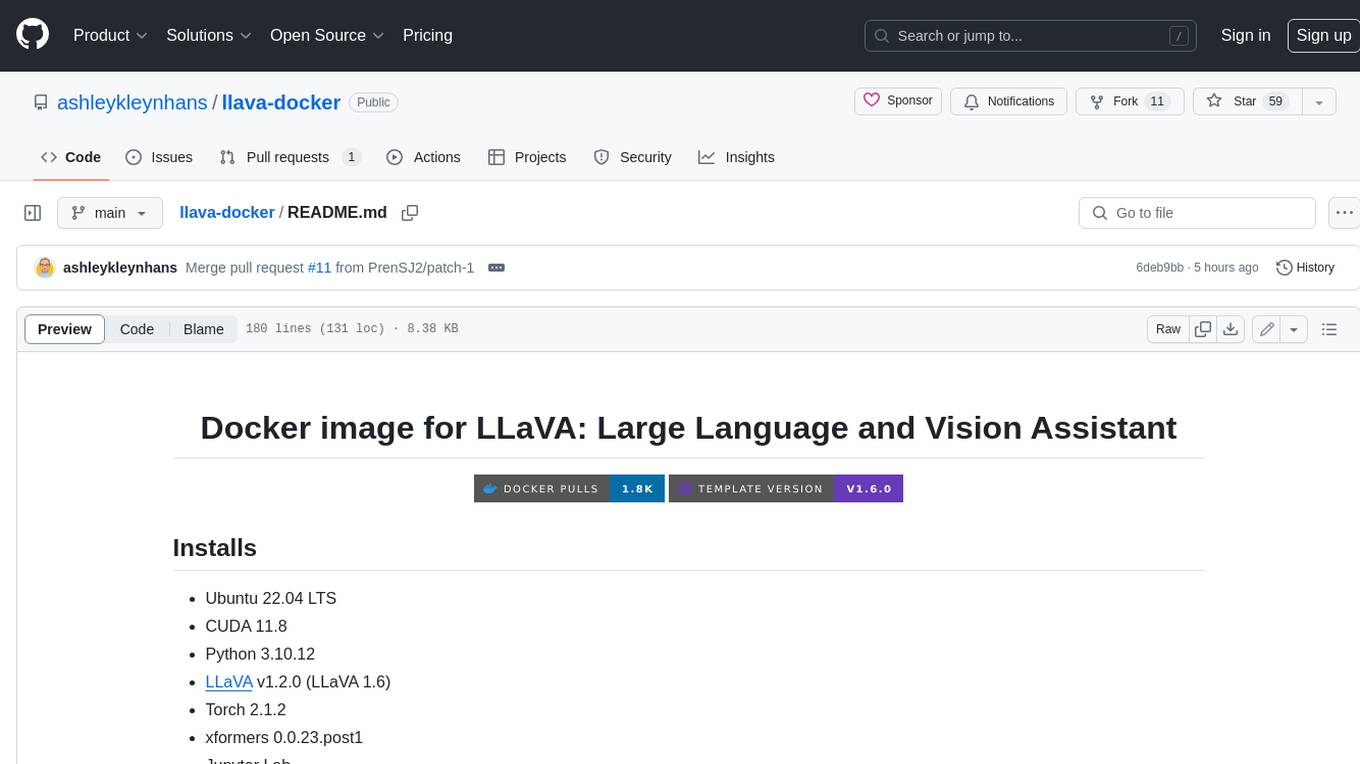
llava-docker
This Docker image for LLaVA (Large Language and Vision Assistant) provides a convenient way to run LLaVA locally or on RunPod. LLaVA is a powerful AI tool that combines natural language processing and computer vision capabilities. With this Docker image, you can easily access LLaVA's functionalities for various tasks, including image captioning, visual question answering, text summarization, and more. The image comes pre-installed with LLaVA v1.2.0, Torch 2.1.2, xformers 0.0.23.post1, and other necessary dependencies. You can customize the model used by setting the MODEL environment variable. The image also includes a Jupyter Lab environment for interactive development and exploration. Overall, this Docker image offers a comprehensive and user-friendly platform for leveraging LLaVA's capabilities.

carrot
The 'carrot' repository on GitHub provides a list of free and user-friendly ChatGPT mirror sites for easy access. The repository includes sponsored sites offering various GPT models and services. Users can find and share sites, report errors, and access stable and recommended sites for ChatGPT usage. The repository also includes a detailed list of ChatGPT sites, their features, and accessibility options, making it a valuable resource for ChatGPT users seeking free and unlimited GPT services.
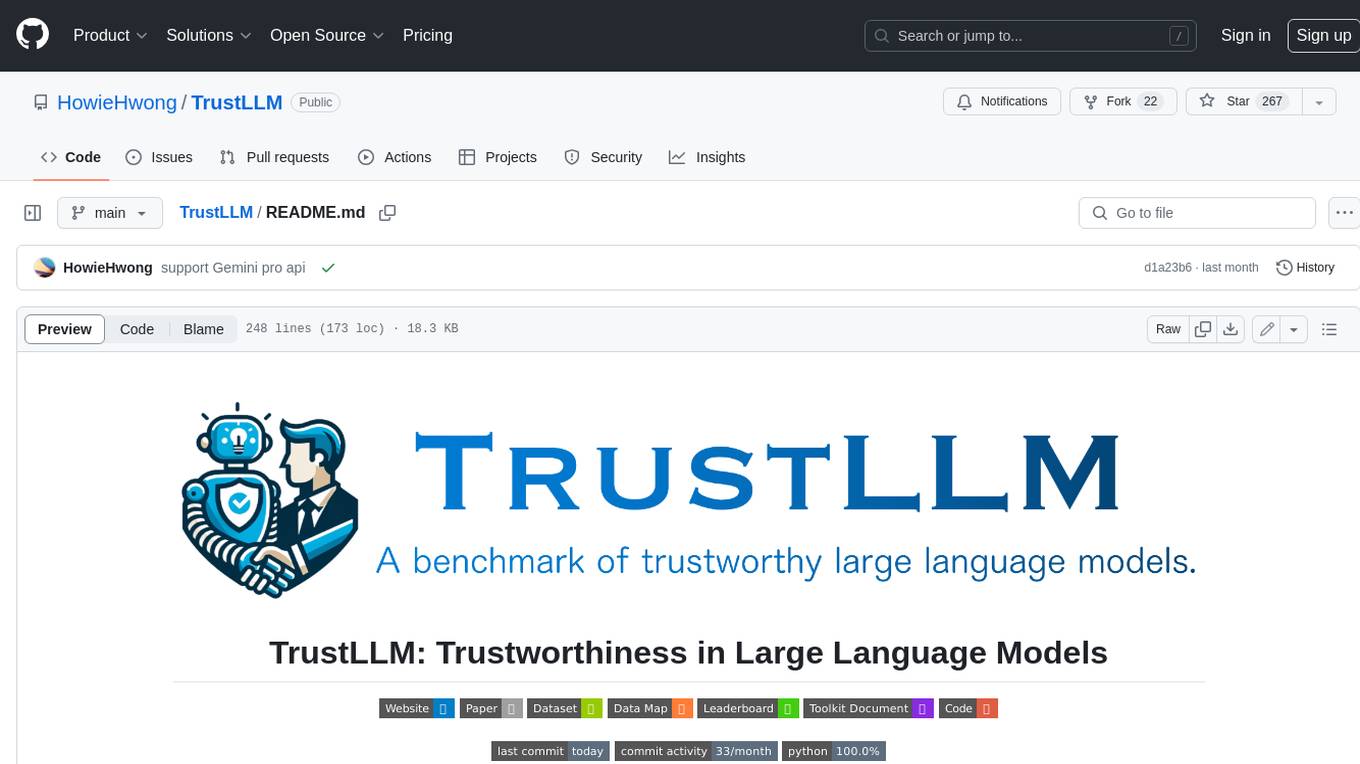
TrustLLM
TrustLLM is a comprehensive study of trustworthiness in LLMs, including principles for different dimensions of trustworthiness, established benchmark, evaluation, and analysis of trustworthiness for mainstream LLMs, and discussion of open challenges and future directions. Specifically, we first propose a set of principles for trustworthy LLMs that span eight different dimensions. Based on these principles, we further establish a benchmark across six dimensions including truthfulness, safety, fairness, robustness, privacy, and machine ethics. We then present a study evaluating 16 mainstream LLMs in TrustLLM, consisting of over 30 datasets. The document explains how to use the trustllm python package to help you assess the performance of your LLM in trustworthiness more quickly. For more details about TrustLLM, please refer to project website.
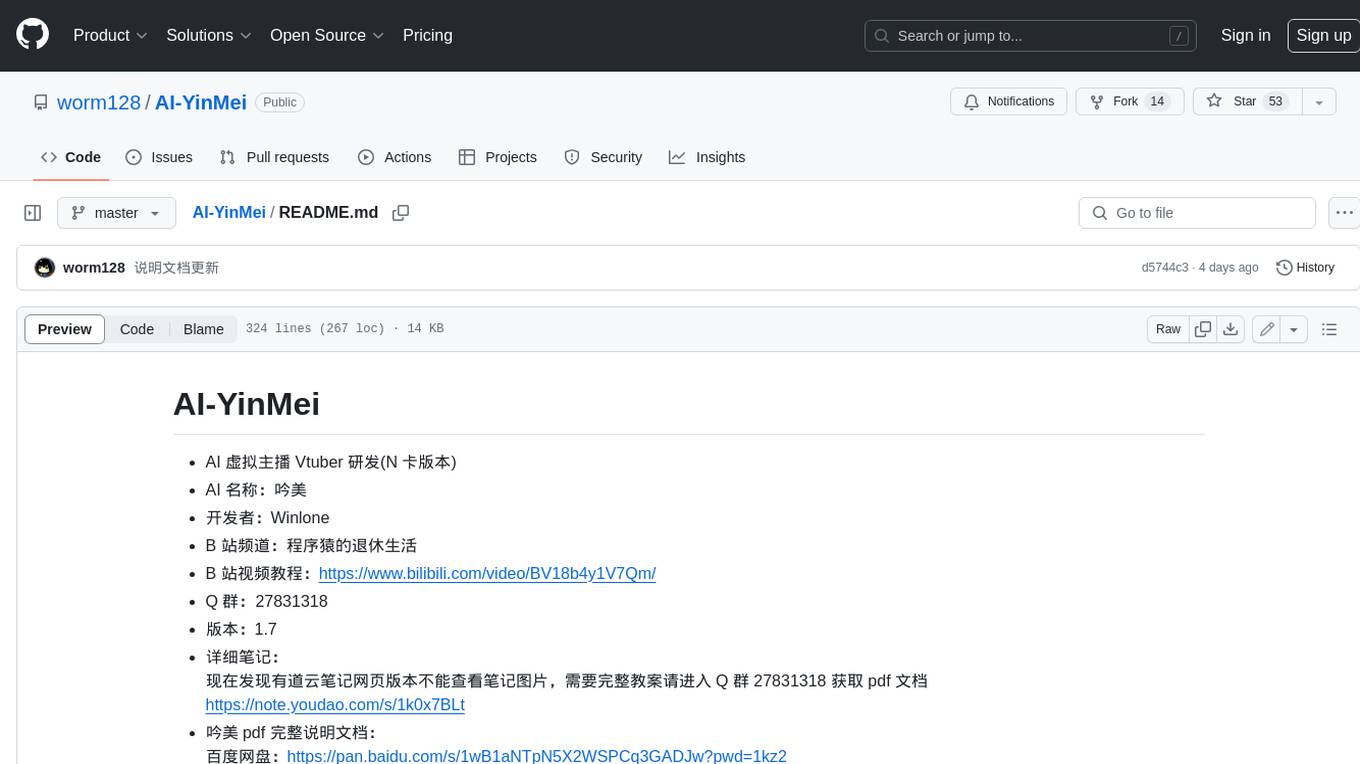
AI-YinMei
AI-YinMei is an AI virtual anchor Vtuber development tool (N card version). It supports fastgpt knowledge base chat dialogue, a complete set of solutions for LLM large language models: [fastgpt] + [one-api] + [Xinference], supports docking bilibili live broadcast barrage reply and entering live broadcast welcome speech, supports Microsoft edge-tts speech synthesis, supports Bert-VITS2 speech synthesis, supports GPT-SoVITS speech synthesis, supports expression control Vtuber Studio, supports painting stable-diffusion-webui output OBS live broadcast room, supports painting picture pornography public-NSFW-y-distinguish, supports search and image search service duckduckgo (requires magic Internet access), supports image search service Baidu image search (no magic Internet access), supports AI reply chat box [html plug-in], supports AI singing Auto-Convert-Music, supports playlist [html plug-in], supports dancing function, supports expression video playback, supports head touching action, supports gift smashing action, supports singing automatic start dancing function, chat and singing automatic cycle swing action, supports multi scene switching, background music switching, day and night automatic switching scene, supports open singing and painting, let AI automatically judge the content.







